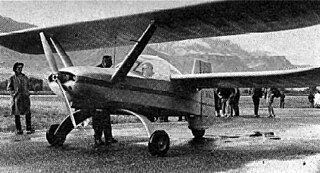Related Research Articles

The Aero Boero AB-115 is an Argentine civil utility aircraft. It was developed from the AB-95-115, a refined AB-95 with a more powerful engine and improved aerodynamics. Specific differences included wheel spats, a redesigned engine cowling molded of fiberglass, and aluminum ailerons and flaps.

The Flying Flea is a large family of light homebuilt aircraft first flown in 1933.

The Croses EC-6 Criquet ("Locust") is a 1960s French two-seat homebuilt aircraft designed by Emilien Croses.

The Lederlin 380L is an unconventional light aircraft developed in France in the 1960s, and marketed for homebuilding.
The Iannotta I-66L San Francesco is a 1960s Italian ultralight designed to be homebuilt from plans. It has been powered by several flat-four engines in the 65-100 hp range and built in both single and two-seat tandem configurations. Only small numbers have been completed.
The APEV Pouchel Classic is a French amateur-built aircraft, designed by Daniel Dalby and produced by APEV of Peynier. The aircraft is supplied as plans or as a kit for amateur construction.
The APEV Pouchel Light is a French amateur-built aircraft, designed by Daniel Dalby and produced by APEV of Peynier. The aircraft is supplied as plans or as a kit for amateur construction.

The APEV Pouchelec is a French amateur-built electric aircraft, that was designed by Daniel Dalby and produced by APEV of Peynier. When it was available the aircraft was supplied as plans or as a kit for amateur construction.

The APEV Pouchel II is a French amateur-built aircraft, designed by Daniel Dalby and produced by APEV of Peynier. The aircraft was supplied as plans or as a kit for amateur construction, but is no longer available. It has been replaced in production by the APEV Pouchel Light

The Legrand-Simon LS.60 is a single-engine, high-wing monoplane seating two side-by-side. It was built in France in the early 1960s in response to a government competition for a club trainer. It won the competition but nevertheless failed to go into production; only the prototype, which still flies, was completed.

The Coupé-Aviation JC-01 is the first of a series of very similar designs of two seat, single engine sports aircraft, amateur built from plans in France from 1976. These provided a range of engine sizes and undercarriage layouts, but total production was small.
The Briffaud GB-10 Pou-Push was a Mignet style tandem wing single seat aircraft with a pusher configuration single engine. The sole example was built in France in the 1980s.
The Aviator Shershen' is a Russian two seat biplane, sold in kit form. It first flew in 2005 and several variants have been produced, with a choice of engines.
The IIL IS-5 was a single seat, high performance sailplane designed by Iosif Șilimon and built in Romania in 1960.
The Langlois JL.2 was a three-winged agricultural aircraft built in France in 1979. It failed to sell and only one was built.
The Landray GL.02 Ami Pou was a very basic, low-powered French tandem wing, single-seat sports aircraft. The only example flew in 1979.
The Landray GL.03 Pouss Pou was a small, pusher configuration tandem wing aircraft built in France in the early 1980s. Only one was completed, though it was much modified.
The Lacroix-Trussant L.T.-51 Microplan was a French, low-powered, two seat amateur-built biplane. It flew just before the outbreak of World War II. After the war it was re-engined and flew until 1953.
The Leduc RL-12 was a French low power, economical, parasol wing, single seat aircraft. First flown in July 1939, its development was halted by World War II.
The Orliński RO-7 Orlik (Eaglet) was a prize-winning Polish home-built aircraft, first flown in 1987. It was restored to flight, with improvements, in 2003.
References
- 1 2 3 4 5 Taylor, John W. R. (1981). Jane's All the World's Aircraft 1981–1982. London: Jane's Information Group. p. 487. ISBN 0710607059.
- 1 2 Etienne-Claude Landray. "Les Avions de Gilbert Landray – GL 1" . Retrieved 27 November 2014.
- ↑ Gaillard, Pierre (1991). Les Avions Francais de 1965 à 1990. Paris: Éditions EPA. p. 147. ISBN 2-85120-392-4.
- ↑ Partington, Dave (2014). European registers handbook 2014. Air Britain (Historians) Ltd.
- ↑ "Les constructions d'Etienne Landray" . Retrieved 27 November 2014.